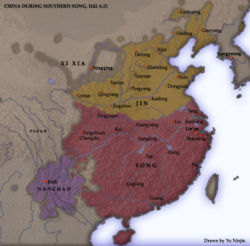- Kingdom of Dali
-
Great Li
大理國← 
937 – 1095
1096 – 1253 →
→Location of Dali in 1142 Capital Dali Religion Buddhism Government Monarchy Emperor - 937-944 Duan Siping - 1081-1094 Duan Zhengming - 1096-1108 Duan Zhengchun - 1251-1254 Duan Xingzhi History - Established 937 937 - Coup d'etat by Gao Shengtai 1095 - Reestablished 1096 - Ended by the Mongol Empire 1253 1253 Dali or Great Li (simplified Chinese: 大理国; traditional Chinese: 大理國; pinyin: Dàlǐguó) was a Bai kingdom centred in what is now Yunnan Province of China. Established by Duan Siping in 937, it was ruled by a succession of 22 kings until the year 1253, when it was conquered by an invasion of the Mongol Empire. The capital city was at Dali.
History
The Kingdom of Dali was preceded by the Nanzhao Dynasty, which was overthrown in 902. Three dynasties followed in quick succession, until Duan Siping seized power in 937 and established Dali.[1] Gao Shengtai forced the puppet king Duan Zhengming to abdicate and become a monk in 1095, and renamed the state Dazhong. He returned the power to the Duan family upon his death. Duan Zhengchun renamed the state Hou Li (lit. "Later Li") in the next year.
The 11th king of Nanzhao established Buddhism as the state religion. Ten of the 22 kings of Dali gave up the throne and became monks.[2].
It is claimed that despite their military prowess and superior numbers, the Mongols could not breach the defenses of the Erhai valley, which was so suited to defense that even just a few defenders could hold out for years. It is said that the Mongols found a traitor who led them over the Cangshan mountains along a secret path, and only in this way were they able to penetrate and overrun the Bai defenders. Thus ended five centuries of independence. In 1274 the Province of Yunnan was created, and thus the region has since been incorporated within China as the result of the expansion of the Mongol Empire at the beginning of Yuan China.
References
- ^ Alfred Schinz (1989). Cities in China. G. Borntraeger. p. 302. ISBN 3443370098. http://books.google.com/books?ei=Sva8TbnPI8Th0gGdsZ24BQ&ct=result&id=pbSwAAAAIAAJ&dq=nanzhao+mongol+dian&q=dali. Retrieved 15 May 2011.
- ^ "Nanzhao State and Dali State". City of Dali. http://www.dali.gov.cn/DefaultStyle/DefaultStyle_NewPage.aspx?PageId=81594.
External links
 Media related to Kingdom of Dali at Wikimedia Commons
Media related to Kingdom of Dali at Wikimedia Commons
This Asian history-related article is a stub. You can help Wikipedia by expanding it.

